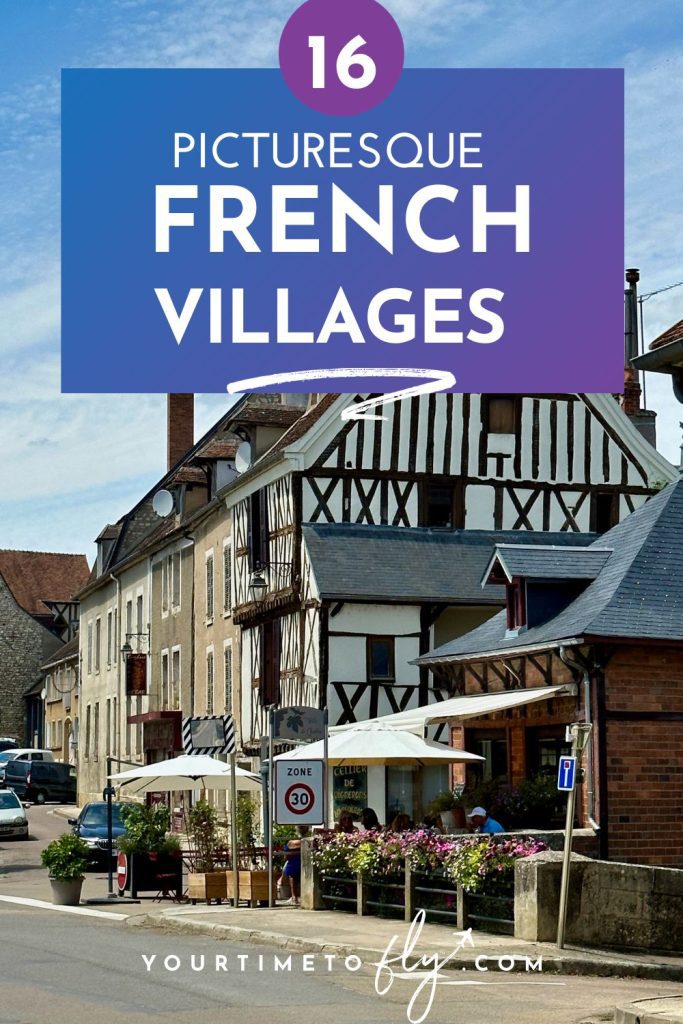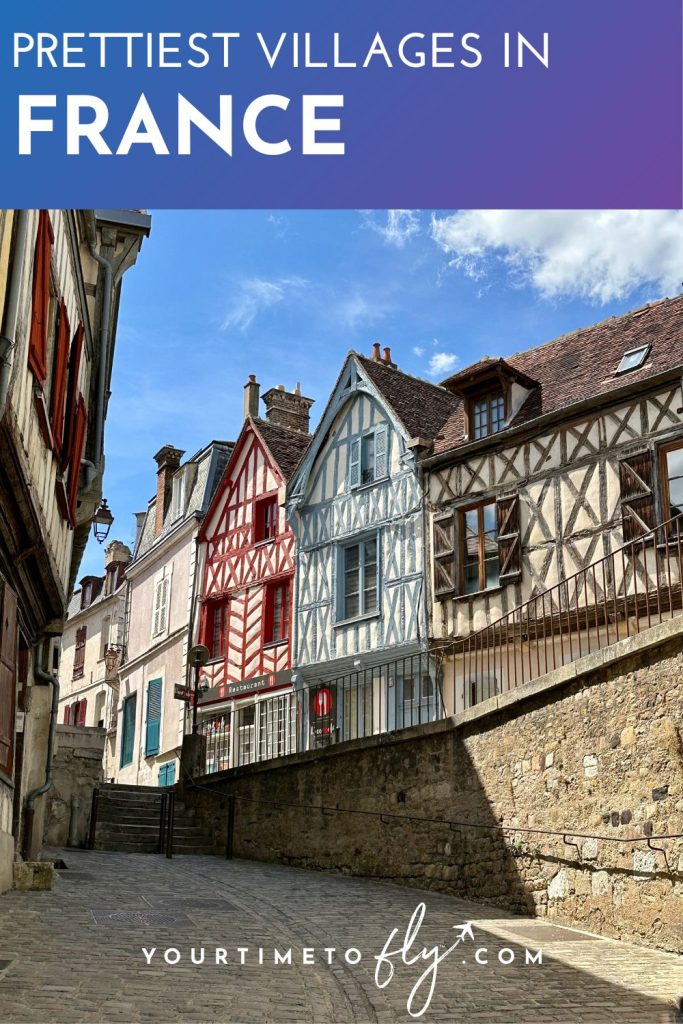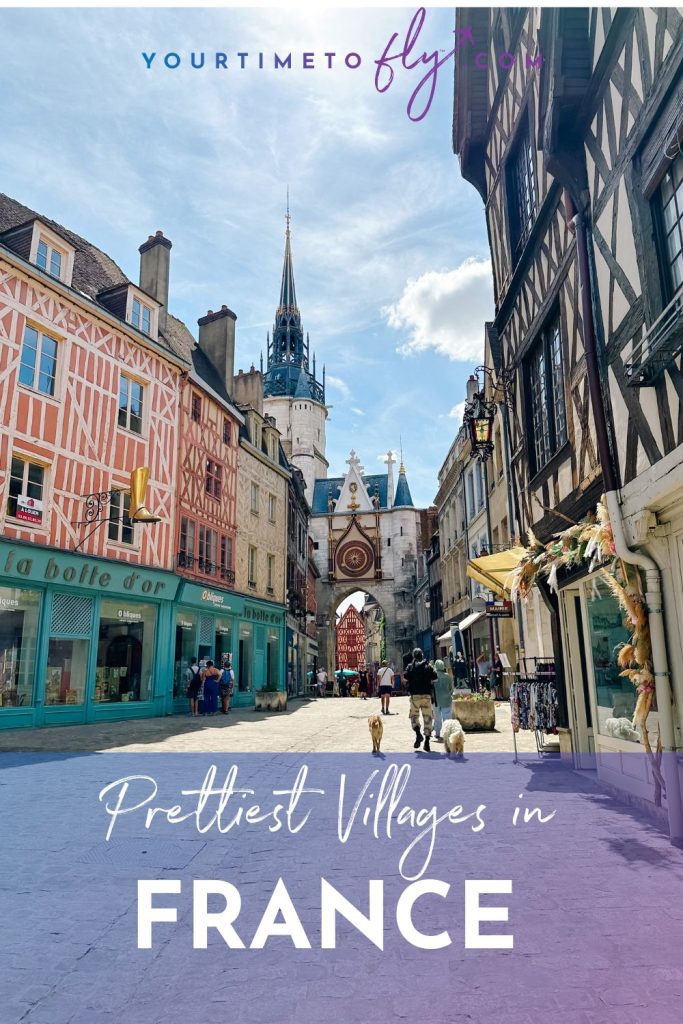Many visitors to France never venture beyond Paris, but I’d encourage you to go off-the-beaten path to enjoy some of the cute small towns in France. I spent a month this summer exploring the most picturesque villages in France and I felt as if I’d stepped back in time. In these fairytale villages, I expected Belle to come around the corner singing “Bonjour” at any moment.
While I love Paris and some of France’s large cities like Bordeaux, for an authentic French experience, you will want to spend time strolling the cobblestone streets past half-timbered buildings in France’s small villages. I still have more of France to explore, but this covers some of the most picturesque villages in Burgundy, Alsace, Bordeaux, Languedoc-Roussillon in Occitanie, and the Basque Coast.
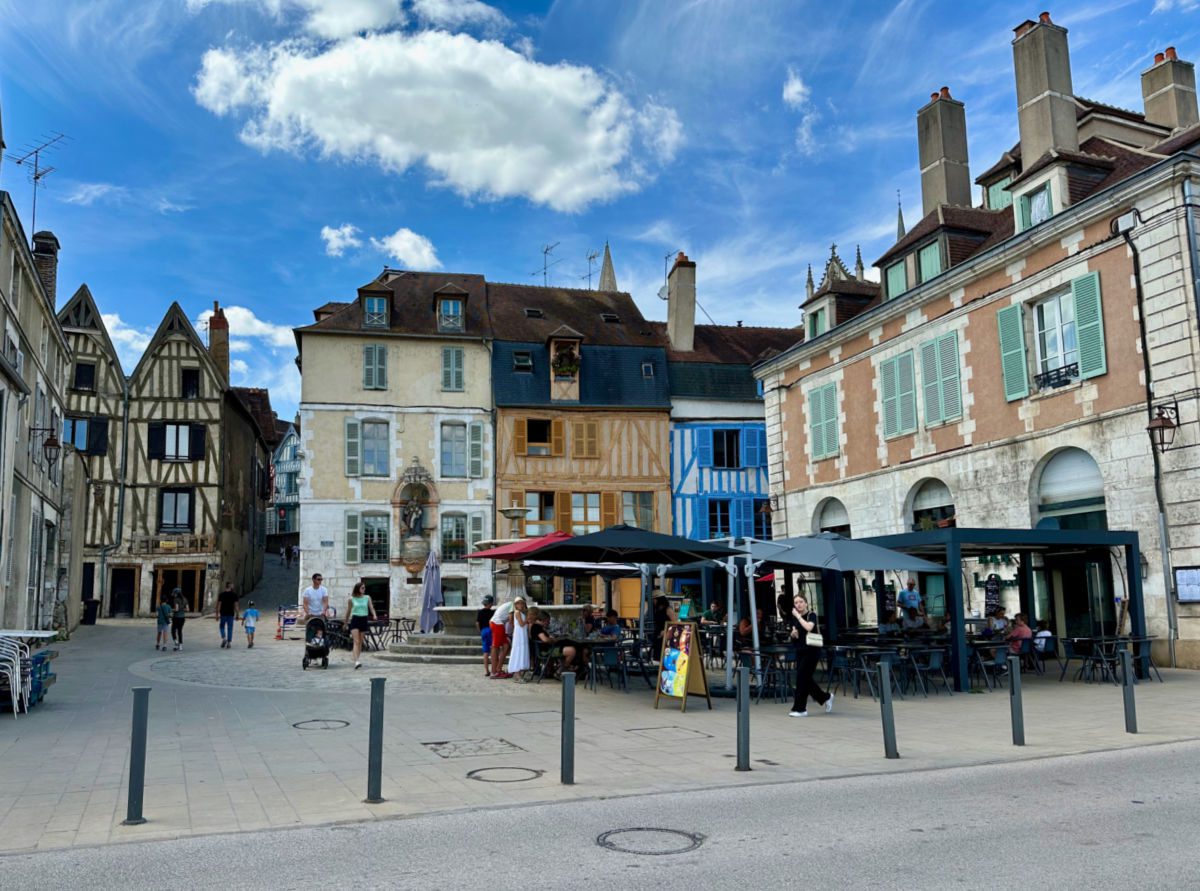
Most Picturesque Villages in France
Since you probably won’t have time to see all of the villages I have included in this article, these are my very favorite towns in each region:
- Alsace: Colmar – I thought Strasbourg was pretty until I walked through Colmar and someone needed to pinch me to convince me that I was in a real place. With its charming half-timbered houses, winding cobblestone streets, and enchanting Petite Venise district, is a picture-perfect embodiment of Alsatian heritage.
- Basque: Biarritz – the former seaside retreat of Napoleon, Biarritz offers stunning beaches, vibrant surf culture, and gorgeous cliffs that make this town something special.
- Bordeaux: St. Emilion – with its UNESCO-listed medieval town center, labyrinthine network of underground tunnels, and stunning vineyards, is undoubtedly one of the prettiest villages in the Bordeaux region.
- Burgundy: Auxerre – with its winding cobblestone streets lined with half-timbered houses, imposing Gothic cathedral, and vibrant market, is undoubtedly one of the prettiest villages in Burgundy.
- Languedoc: Pézanas – with a lively weekly market, charming medieval streets, and shops galore, this town is unmissable.
Picturesque Villages in Burgundy
Located in Eastern France, Burgundy is a region steeped in history, culture, and, of course, wine. Known for its world-renowned Pinot Noir and Chardonnay, Burgundy’s vineyards stretch across rolling hills and limestone-rich soils, creating the perfect conditions for producing some of the world’s most sought-after wines.
The main cities are Dijon and Beaune, but Burgundy also boasts a rich tapestry of medieval towns, grand abbeys, and picturesque villages, each with its own unique charm and character. While Burgundy is not as widely visited as some other regions of France, it is a popular destination for those seeking a taste of authentic French culture and cuisine.
One way for those that love slow travel, amazing food, and incredible wine to explore Burgundy is via a hotel barge cruise through the Burgundy canals. I had the opportunity to visit Burgundy and its charming villages on the Hotel Barge Elisabeth.
Auxerre

Auxerre was such a surprise to me and the prettiest village I visited in Burgundy. This town truly looks like a fairy tale or what a theme park would create as a typical French village. Strolling through winding cobblestone streets that are lined with half-timbered houses adorned with vibrant flowers, I felt transported back in time.
This town is larger than some nearby villages, so you will want at least half a day to explore the main attractions and give yourself enough time to take the ten thousand pictures you are going to want to capture. The Tour de l’Horloge, a 15th-century clock tower, truly looks like something from a Disney park.
You also shouldn’t miss visiting the Abbaye Saint-Germain, a former Benedictine monastery which now houses the Musée d’Art et d’Histoire. The architecture is lovely but the museum has a fascinating collection of art and artifacts that chronicle Auxerre’s past from Ancient Roman times. Cathédrale Saint-Étienne is a magnificent Gothic masterpiece that is also worth a visit.
The area around the clock tower is full of shops and restaurants, many with sidewalk tables if you want to enjoy a coffee or drink and people watch for a while. For a sweet treat, stop in to Chocolaterie Olivier Vidal.
Chablis
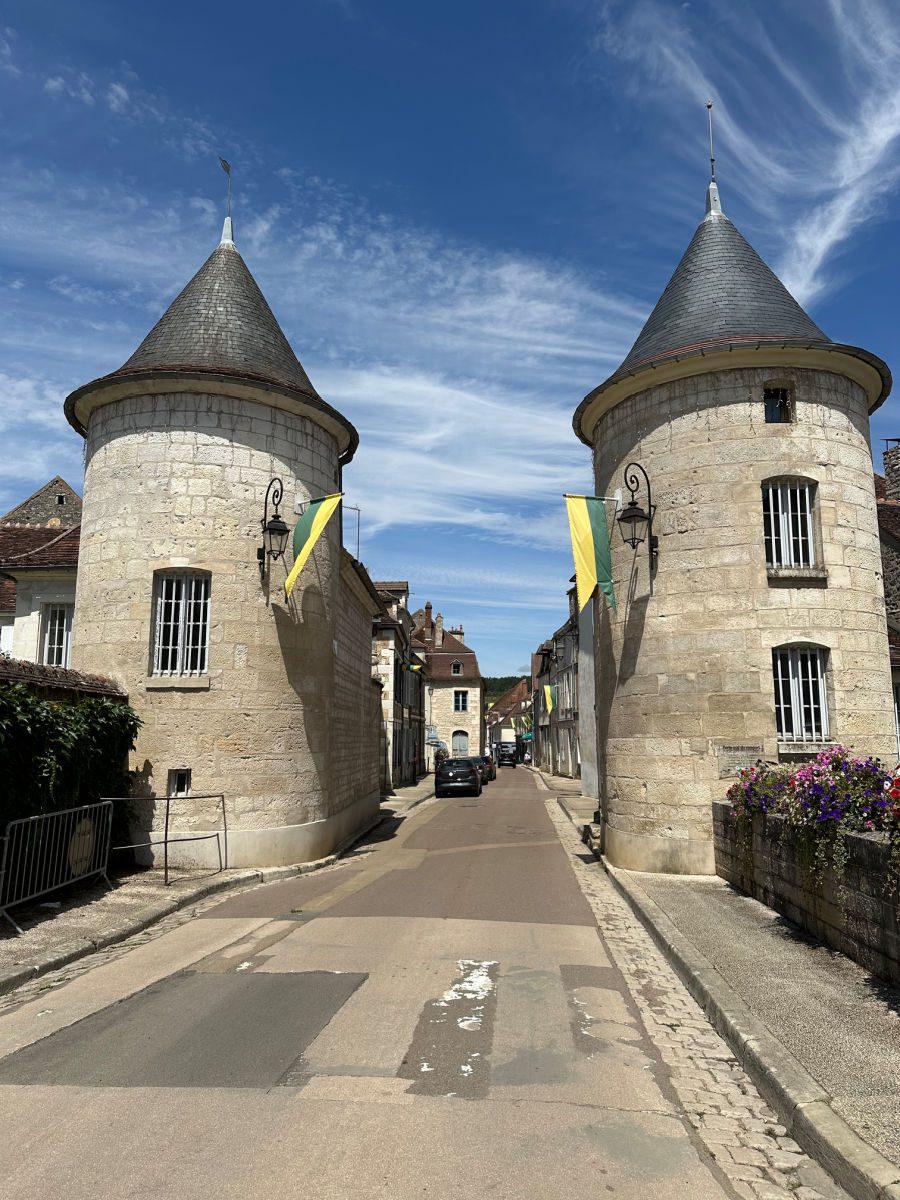
Surrounded by rolling hills and vineyards, Chablis is renowned for its world-class Chardonnay wines. If you drive to the observation deck above the Grand Cru vineyards, you get a lovely panoramic view of the vineyards and towns beyond.
There are plenty of restaurants in town, from the gourmet Hostellerie des Clos to the casual restaurant at the Hôtel de la Poste. There are also a few wineries in town where you can go wine tasting, such as Domaine Servin. The town is quiet and beyond charming, especially when you feel like you have the whole place to yourself!
The joy of Chablis is just wandering through town, but you should stop into the Collégiale Saint-Martin de Chablis church, walk past the Hôtel du Ville which is the town hall, and along the Serein River to see the bridges adorned with flower boxes and the old lavoir which was once used for washing laundry.
For a unique experience nearby, drive Bailly Lapierre, the birthplace of the AOC Crémant de Bourgogne, where you actually drive into underground caves for wine tasting.
Joigny
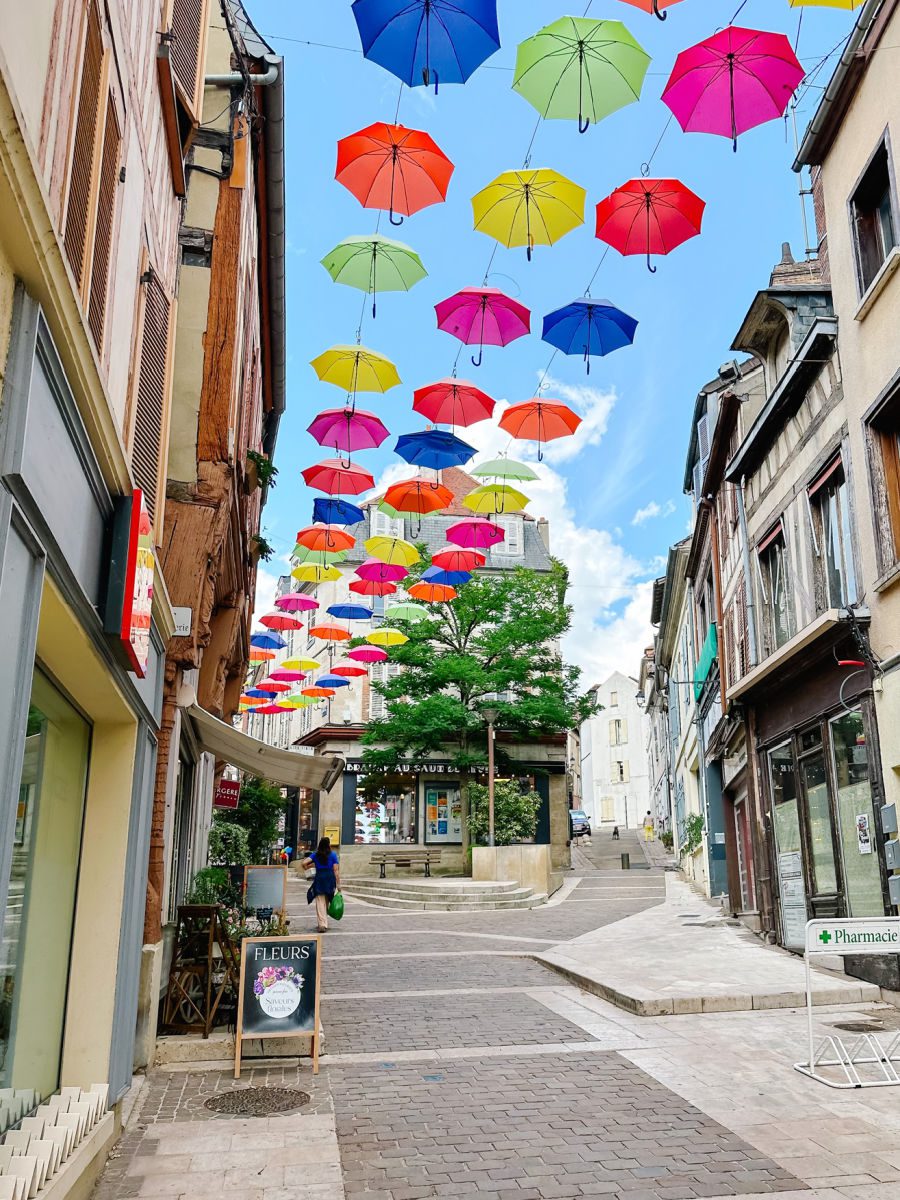
The small town of Joigny on the Yonne River has a historic center that has been designated a “City of Art and History.” I enjoyed strolling through the town’s labyrinth of winding cobblestone streets lined with half-timbered houses adorned with vibrant flowers. These picturesque dwellings, many dating back to the Middle Ages, showcase the town’s rich architectural heritage. Make sure to pop into Église Saint-Jean, a Gothic church with awe-inspiring stained glass windows.
Vezelay
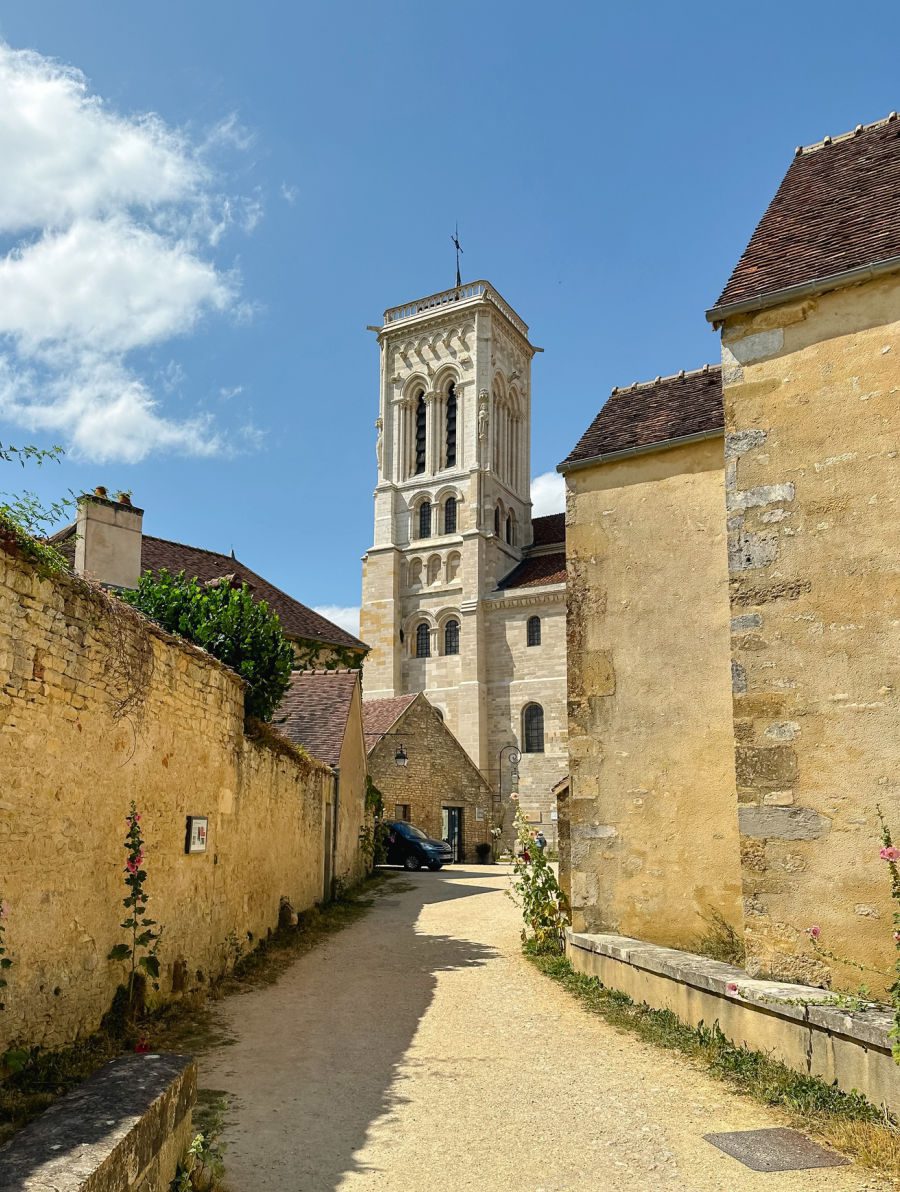
Vezelay is home to a UNESCO World Heritage site. Located on a hilltop, this medieval town is a Catholic pilgrimage site. The 12th-century basilica is where St. Bernard delivered his rousing speech before the 2nd Crusade in 1147, and where Richard the Lionheart joined forces with King Philip II of France in 1190 before the 3rd Crusade. In the crypt below the church, there are said to be relics of the Virgin Mary.
The town has beautiful views of the vineyards and rolling hills that surround Vezelay. The main street is lined with art galleries and shops. There is also a wine shop that offers wine tastings in a 12th-century wine cellar.
Prettiest Villages in Southwestern France
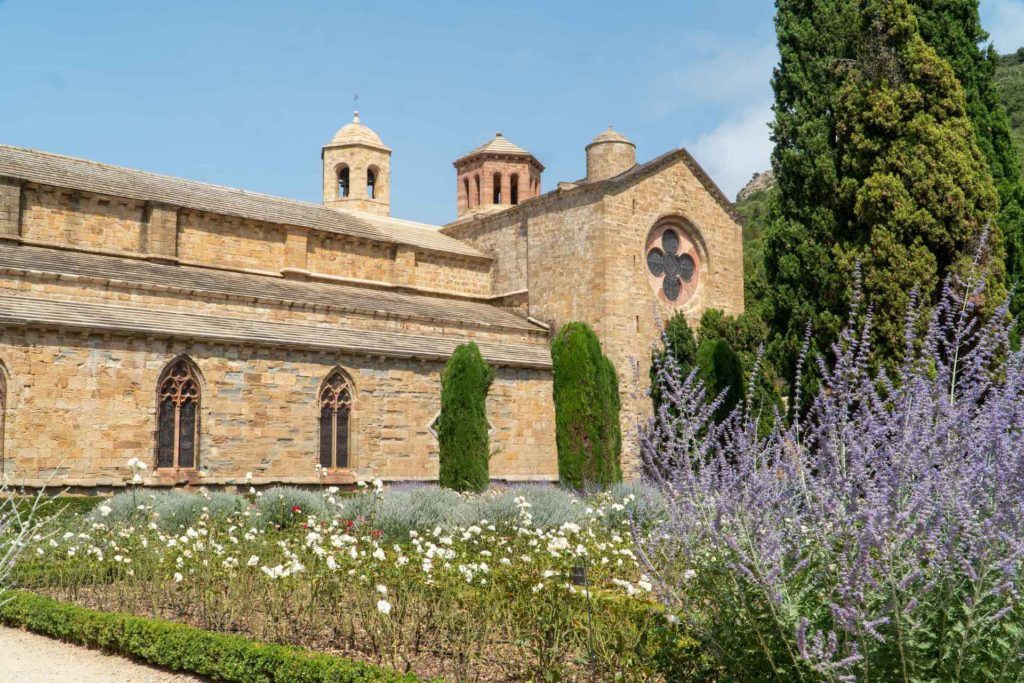
The Languedoc is a region in the South of France that many Americans have never heard of. Nestled between Spain and the Midi-Pyrénées to the Southwest and Provence to the East, this section of Occitanie offers sandy beaches, Cathar castles, charming towns, and colorful gardens that soak up the Mediterranean sunshine. The main cities are Montpellier and Toulouse, but there are so many quaint villages in Languedoc to explore that are off the main tourist path.
When people consider a visit to the South of France, they usually first look at either Provence or the French Riviera. Yet the primary advantage of Languedoc over its neighbors comes down to affordability and accessibility. You can find adorable towns, ancient abbeys, delicious food, great wine, and plenty of sun without paying the premium or dealing with the crowds you find in those other regions. I first visited Languedoc on a wine tasting trip with my husband and later returned to take a barge cruise on the Canal du Midi with a friend.
Southwestern France also covers the region around Bordeaux and the Basque Coast.
Pézenas
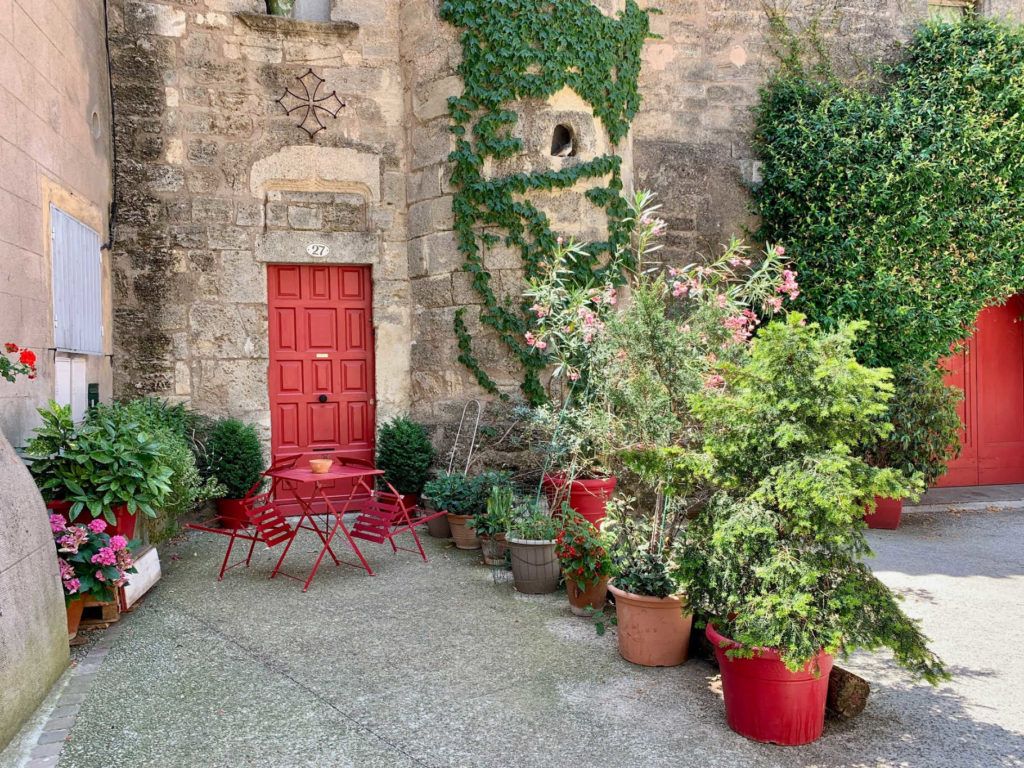
Of all the towns I have visited in the Languedoc, Pézenas near Montpellier was the most charming. I’ve visited twice and each time I was enchanted. If you visit on a Saturday, during market day, the town will be bustling with both tourists and locals picking up their weekly goods. Try to visit early in the morning, arriving by 9:30 or 10:00 to beat the crowds.
There are car parks in town, but if those are full there is an overflow lot just out of town that is only a 5-10 minute walk into the historic town center. The town center is a maze of narrow cobblestone streets lined with old stone buildings adorned with colorful shutters or doors. Flowers hang from window boxes and locals gather boisterously in outdoor cafes. The town is known for its artisan goods, creating a shopping paradise for those seeking authentic, local finds.
When you get hungry, stop into Café Brasserie Chez Hansi or enjoy some tapas at La Mamita.
Mirepoix
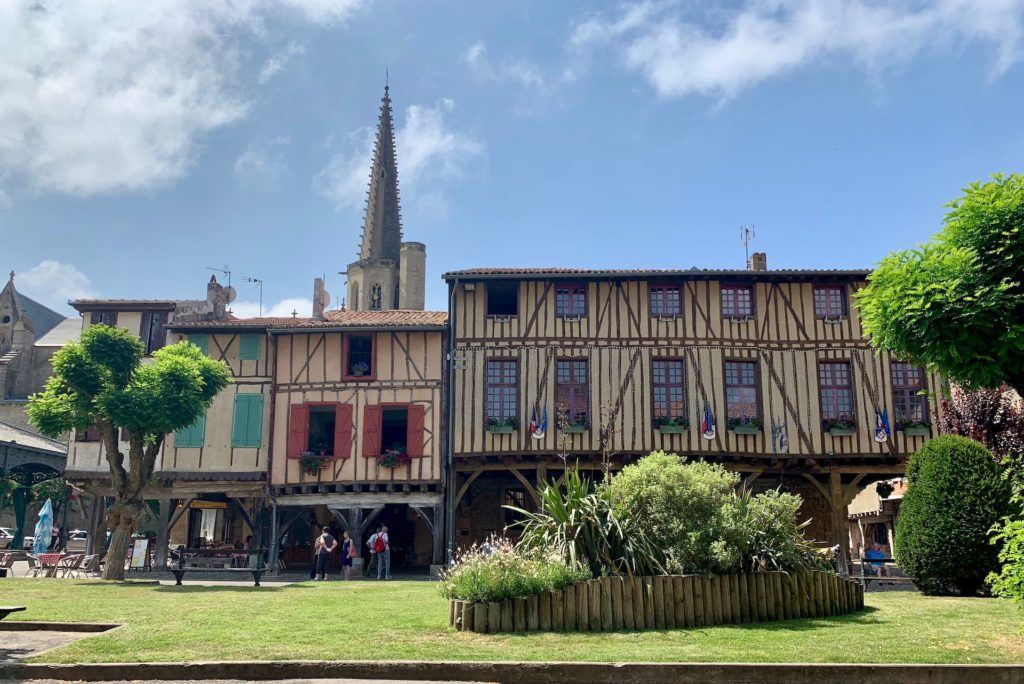
As soon as we arrived in Mirepoix, I felt that I had walked into the pages of a storybook or a Disney set. The town square, with its surrounding buildings braced by old timbers, looks so French it looks fake. It is almost hard to imagine that towns still exist like this and not just recreations the way we think a French village should look.
Yes, there are souvenir shops that line the town square, along with a small carousel, but charm oozes from every corner. The Tour de France passes through Mirepoix in the summer, so don’t be surprised to see a few bike groups gathered there also as they do their imitation rides. If you can, visit on Monday, which is market day.
Limoux
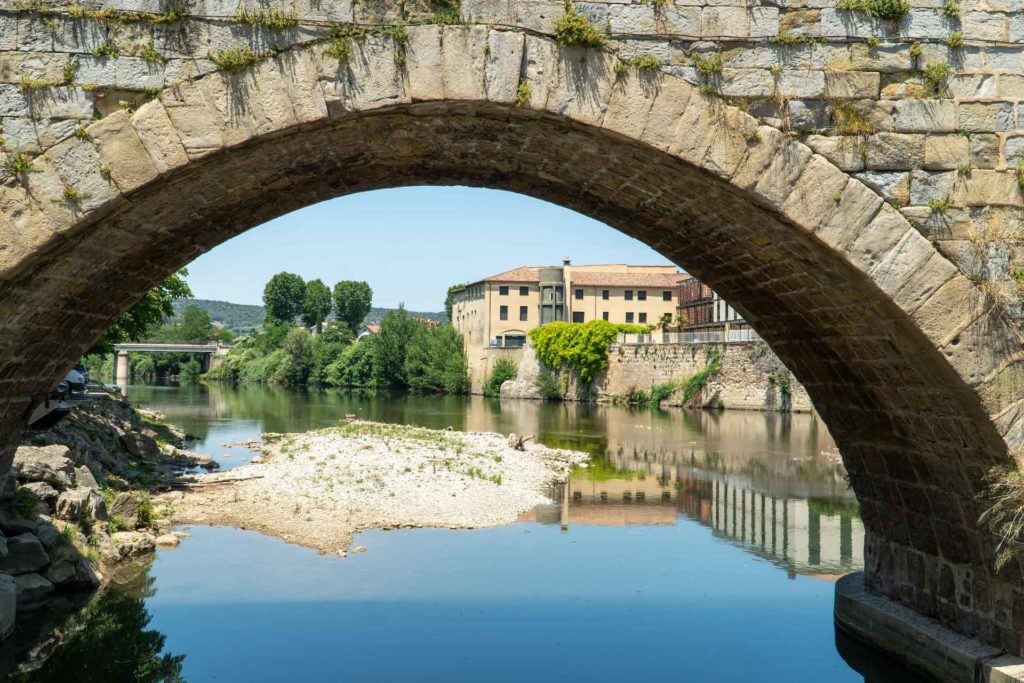
If you continue on from Mirepoix to Limoux, you will come to the heart of the region that produced the first sparkling wine (before Champagne), known as Blanquette de Limoux. Today the region is famous for Chardonnay, Chenin Blanc, and the sparkling Cremant de Limoux. There are wineries in the area that you can arrange to visit (note they are closed on Sunday), or you can stop into Antech Limoux on the outskirts of town.
There is a wide square called Place de la République in the heart of town, where you can find many restaurants. We had a lovely lunch at Chez Stephan. Just remember that in French villages, lunch is served strictly between 12 and 2pm. If you do not arrive by 1-1:15, you may not be served, so plan accordingly.
After lunch, take a walk along the River Aude and across one of the bridges to the Petite Ville on the Eastern Side. This area is a bit reminiscent of the Arno in Florence.
Lagrasse
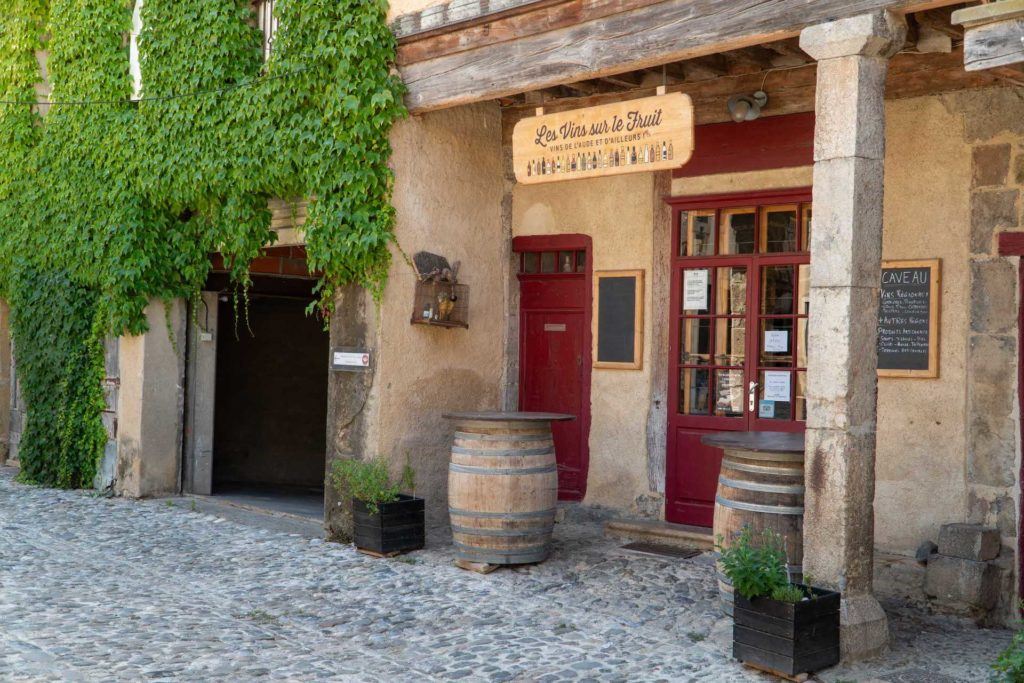
Halfway between Narbonne and Carcassonne, you come to the beautiful town of Lagrasse. You could squeeze this into a day trip combined with Mirepoix and Limoux, or spend the morning here before continuing on to Perpeyteuse in the afternoon.
There is plenty of parking outside of town, but you will need to pay at a meter and leave the slip on your dashboard. Be prepared to do a lot of walking and wear comfortable shoes and bring along lots of water in the summer. You may actually want to wear a swimsuit and pack a towel because there is a small rocky beach along the river where locals swim and wade in the water to cool off.
This medieval town features book and pottery fairs at the covered market in the summer, and there is plenty of shopping. The main attraction is the Benedictine Abbey located across the river from town.
Today, the Abbey of St. Mary of Lagrasse is divided into two sections. Each can be visited but require separate tickets. The buildings aren’t nearly as impressive as the Abbaye Frontfroide near Narbonne so you can decide which, if any, you want to visit depending on how much time you have in Lagrasse.
Minèrve
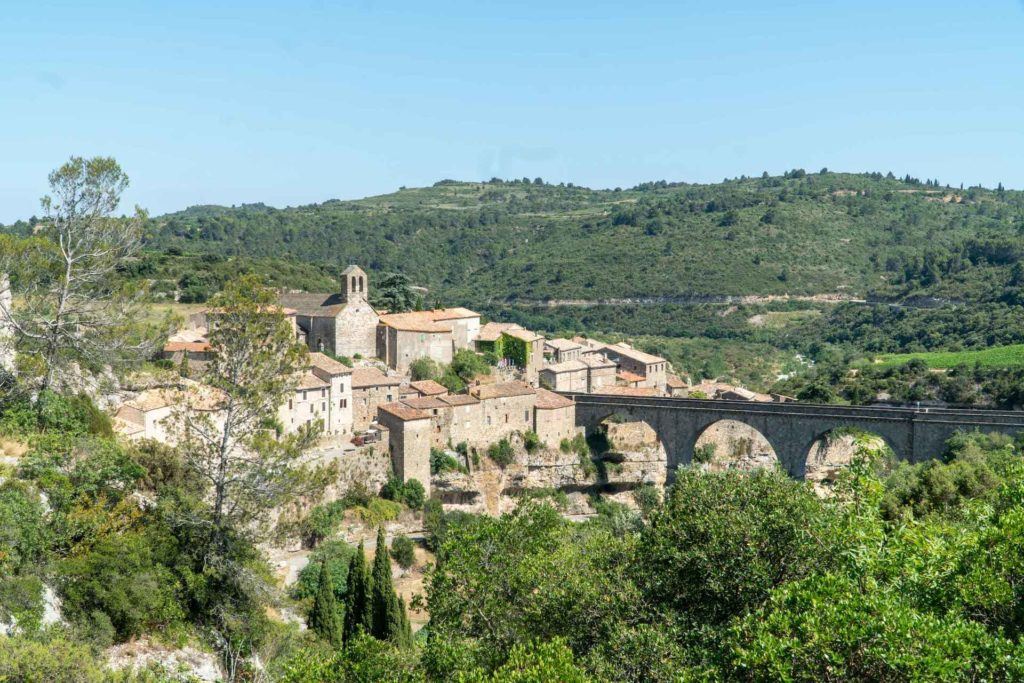
Minèrve is often thought of as one of France’s most beautiful villages, but its precarious location on a rocky peninsula overlooking deep gorges, keeps many tourists away. It doesn’t take long to explore this small town, but it is still worth the trip to see the sweeping views and its picturesque setting. You will need to park outside of town and walk over, so be prepared for an uphill climb on the return trip.
You can see some of the medieval fortifications, pop into the small shops in town, and peek into the 12th century church. Make sure to also get a picture from the impressive double-arched bridge that spans the River Cesse before you leave.
Carcassonne
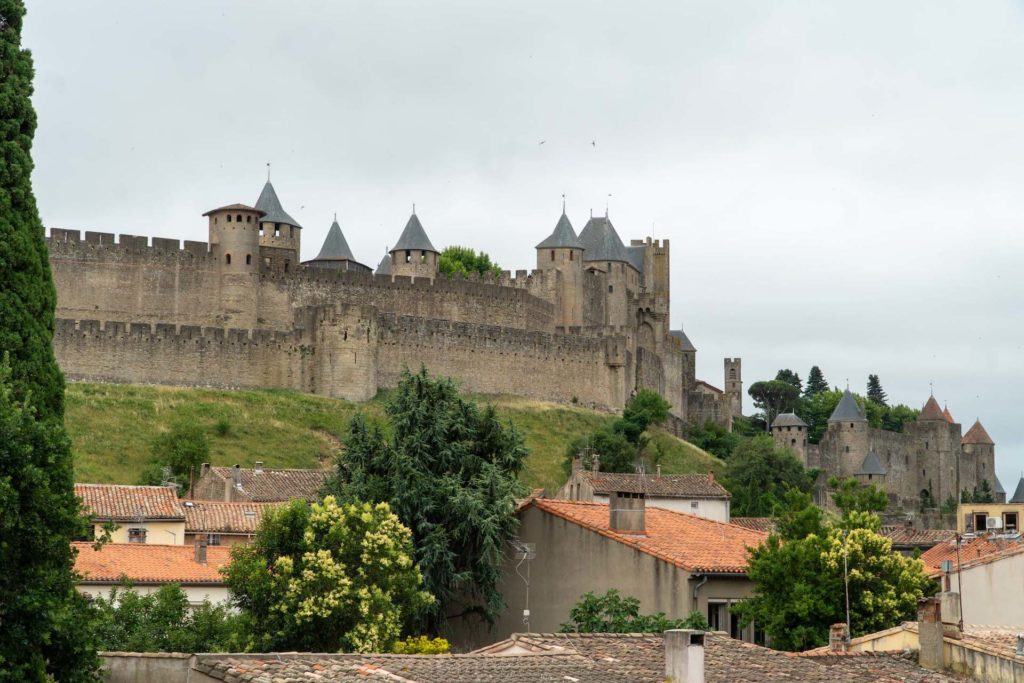
Carcassonne is the second most visited site in France, outside of Paris. This 2,500-year old medieval city looks like a massive fairytale castle from afar, protected on all sides by thick walls dotted with cone-shaped turrets.
The town is actually much smaller than it looks from a distance and the streets can get quite jammed with visitors during the high season. Your best bet is to park in the car park outside of the main gate of Porte Narbonnaise. If you arrive about an hour before the castle opens, you can have some time to explore the Basilica and town before the masses arrive (and it will be easier to find a parking spot.)
The old city is free to explore, but you will need to pay an entrance fee to access the main attraction, the Chateau / castle. Try to be in line before it opens so that you can explore before it gets jammed with tour groups. You can also take a walk along the ramparts of the city to get beautiful views of the valley surrounding Carcassonne.
After you have explored the Old City, you can walk down to the Lower City for lunch and shopping. We also enjoyed a nice wine tasting at Comptoir de la Cite.
Narbonne
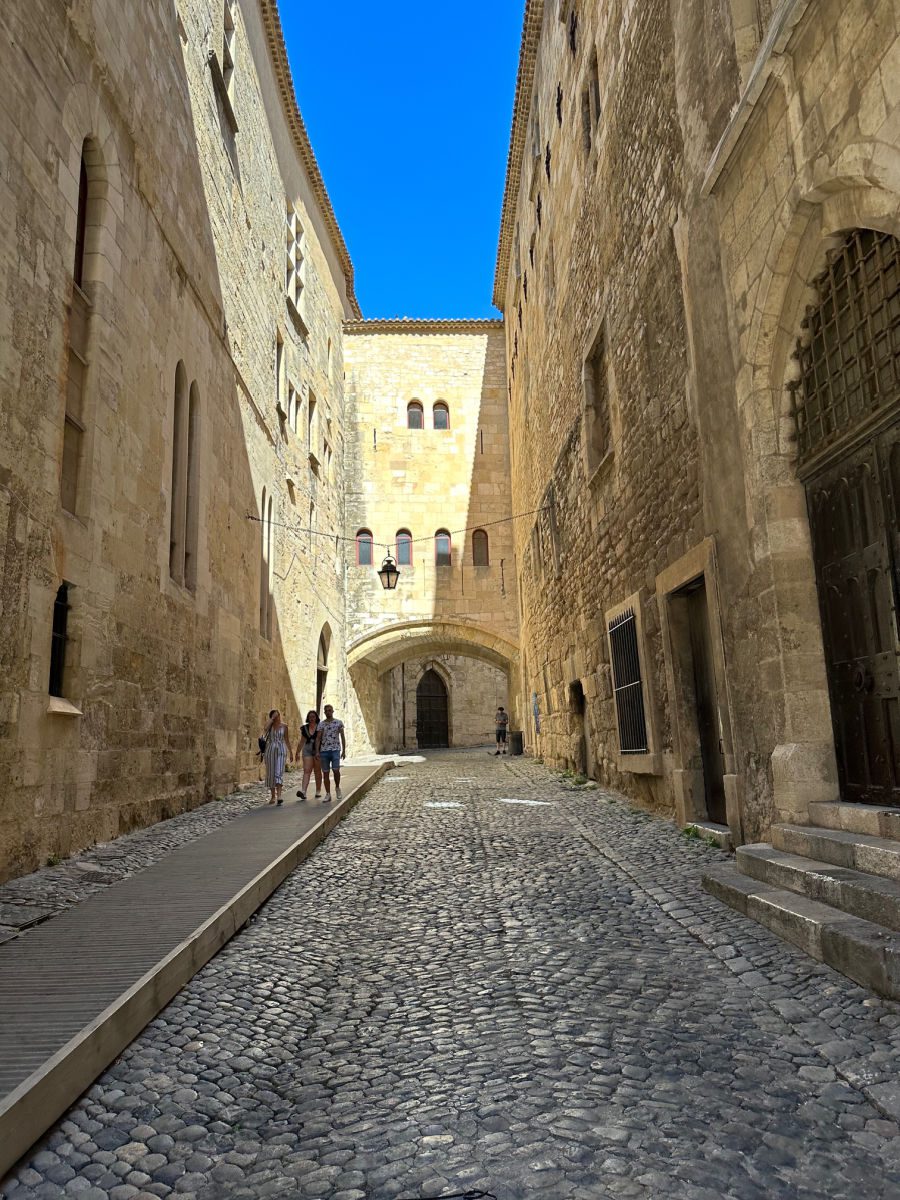
If you are also interested in visiting a small city, I would recommend a half-day in Narbonne and an afternoon at the plage (beach). The center of Narbonne is beautiful, with arched bridges lined with flowers over the canal such as the Pont des Marchands (The Merchant’s Bridge).
There are a few sites that can’t be missed including the Donjon Gilles Aycelin tower, the Cathedral and its Treasury, and the Les Halles covered food market. Narbonne was on the road to Rome and you can still see Roman Ruins in the middle of the city and visit the Horreum subterranean warehouses that date back to the first century B.C.
About 20 minutes outside of Narbonne, plan on spending a few hours exploring the Abbaye de Fontfroide. Fontfroide Abbey is nestled in the foothills of the Pyrenees and is a former Cistercian place of worship. The buildings have been kept in pristine condition under private owners, with photogenic cloisters and courtyards. Don’t miss the beautiful rose garden outside of the Abbaye.
Le Somail
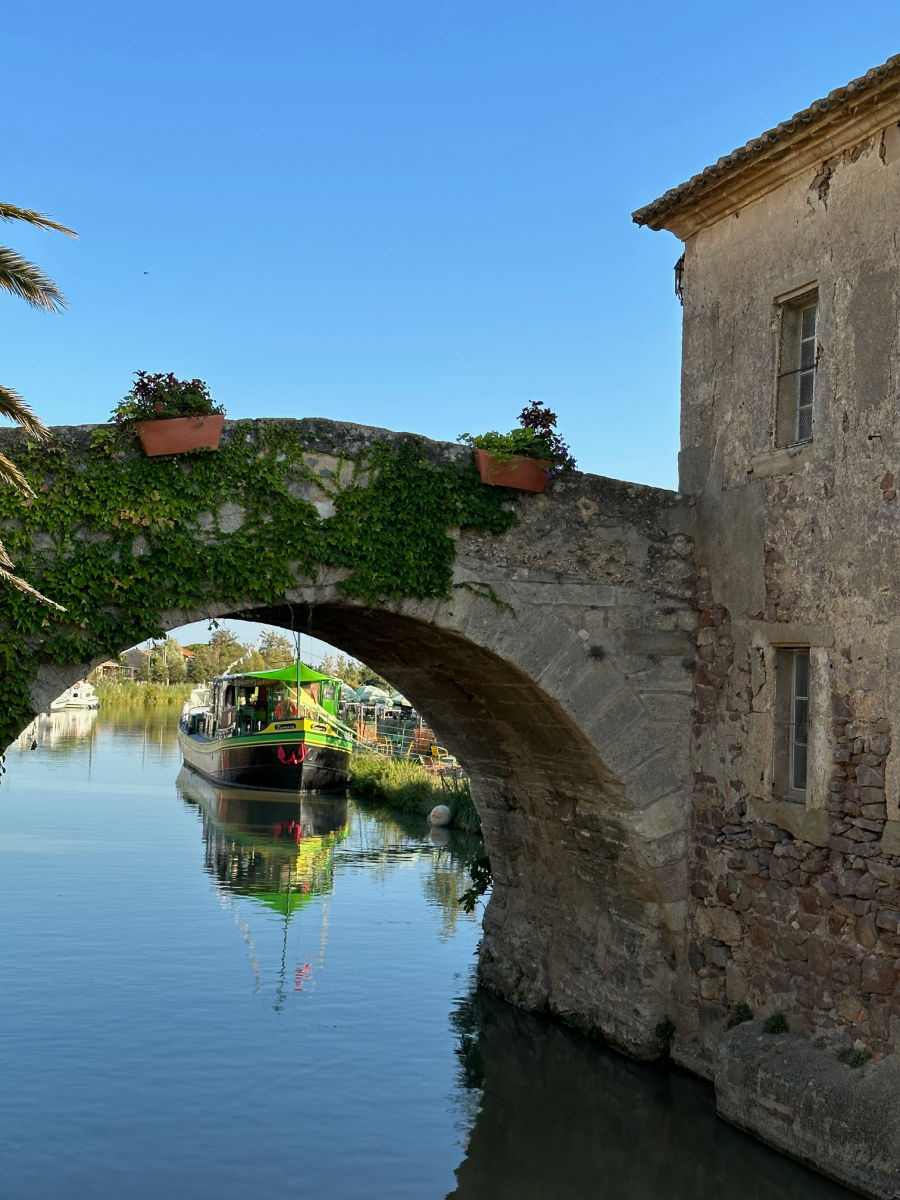
The tiny village of Le Somail is one of the most charming on the Canal du Midi. While there isn’t much to see, walking around town makes you feel like a local. Enjoy a meal at one of the restaurants along the Canal and take a walk along the towpath. If you love books, be sure to check out the Le Trouve Tout Du Livre book store for volumes in French and other languages.
Marseillan
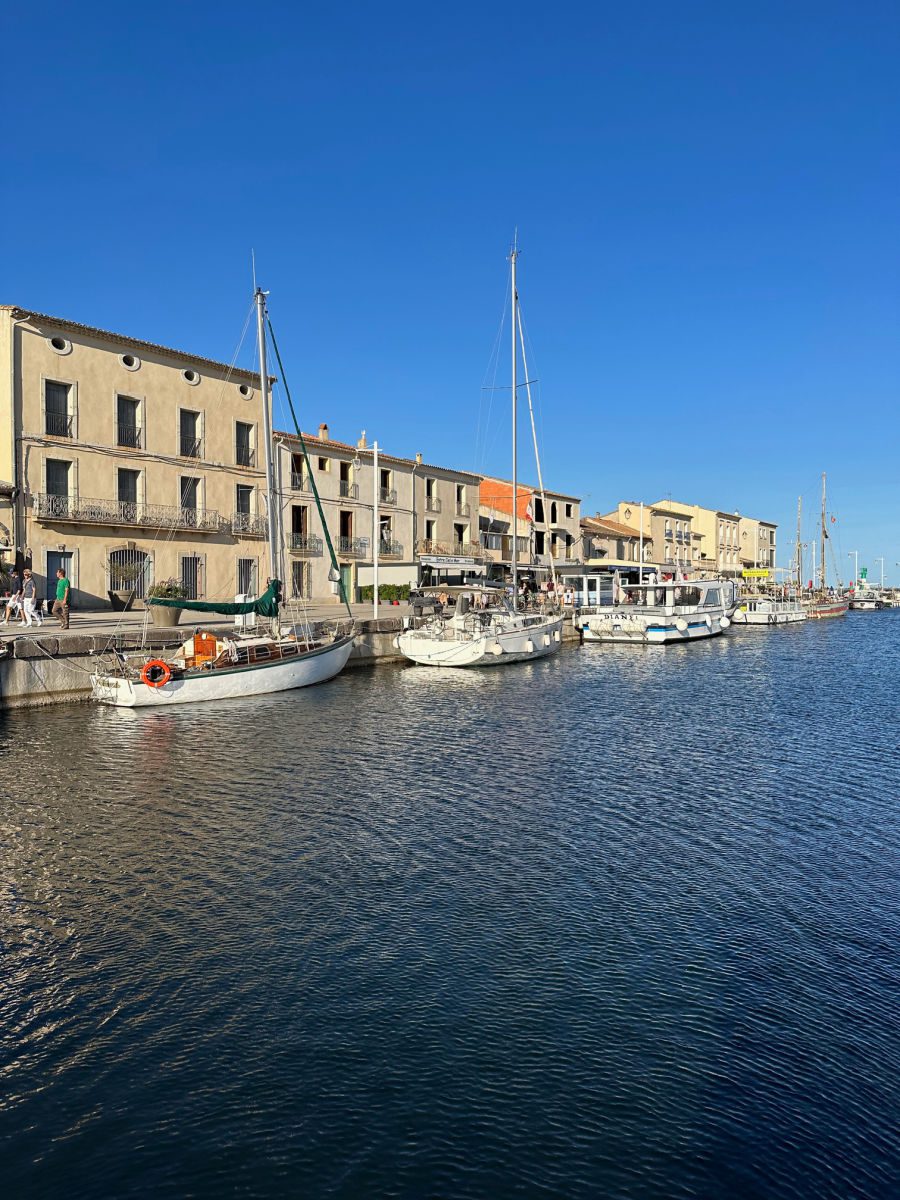
Marseillan is located at the entrance to the saltwater lake of Étang de Thau on the Mediterranean Coast, famous for its oyster beds and pink flamingos. The lake offers opportunities for kayaking, sailing, and windsurfing and the town’s beaches sunbathing, swimming, and enjoying the Mediterranean Sea. This charming seaside town is wrapped around a picturesque harbor with a smattering of restaurant and shops. Wandering through its winding cobblestone streets, you will see evidence of the town’s Cathar history.
The town’s rich history is evident in its landmarks like the 12th-century Église Saint-Étienne, a magnificent Romanesque church, and the 16th-century Tour de Guiral watchtower. Marseillan is also home to Noilly Prat, one of the leading Vermouth producers with a nearly 200 year history, where you can take a tour or have a tasting.
Saint-Émilion

When I took a Bordeaux river cruise, Saint-Émilion was the town I was most excited to visit and it lived up to my expectations! The town’s historic center is a UNESCO World Heritage Site, and it is a maze of narrow, winding streets lined with half-timbered houses and charming shops.
The town’s most famous landmark is the Église Monolithe, a remarkable church that was carved into a single block of limestone. Saint-Émilion is also famous for its underground tunnels, which were dug by the town’s inhabitants over centuries. The tunnels were used for a variety of purposes, including storage, shelter, and even religious ceremonies and today you tour the tunnels.
Of course, no visit to Saint-Émilion is complete with some wine tasting and the main streets through town are lined with wine shops and wineries offering tastings of some of most sought-after wines in the world.
Biarritz
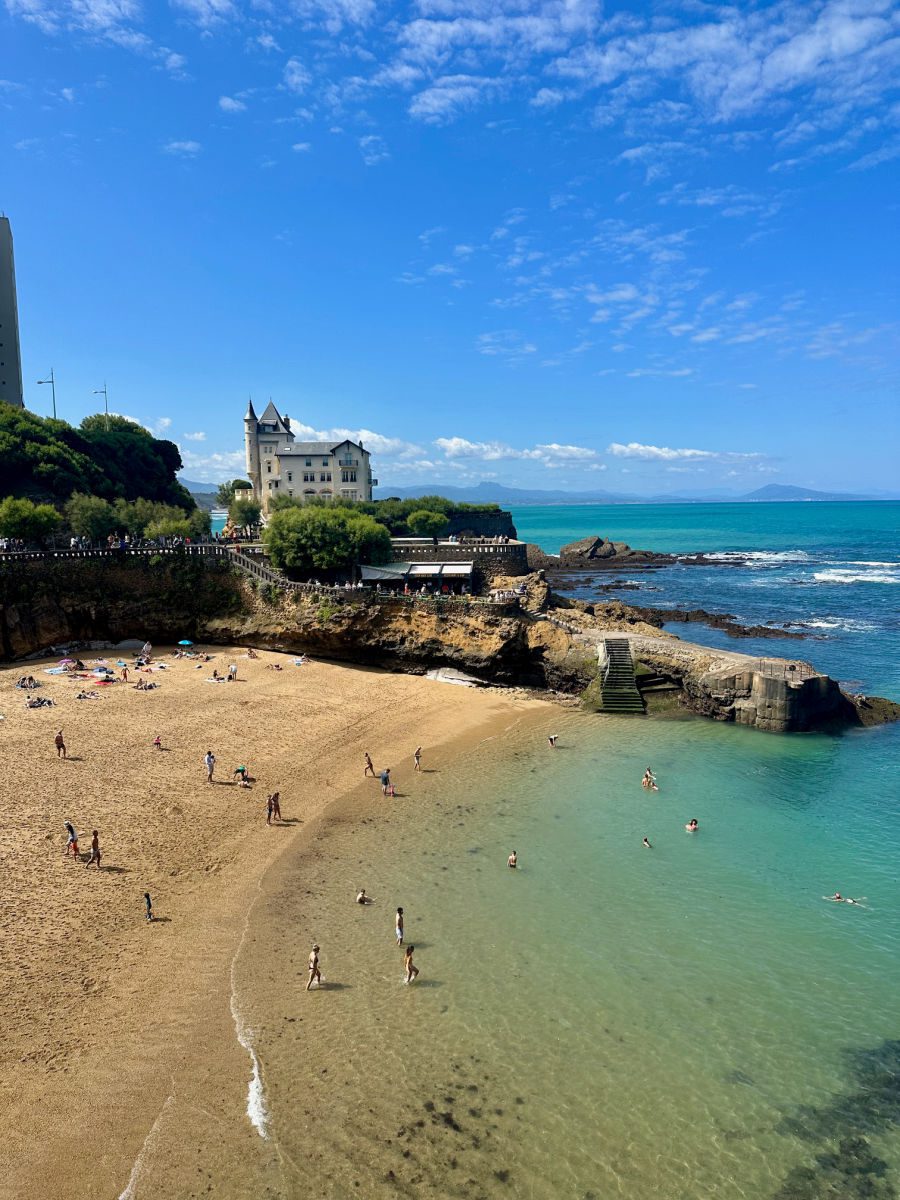
After our Bordeaux river cruise, we headed down to the Basque Coast for a few days of relaxation in Biarritz. Long before surfers flocked to Biarritz to ride the big waves, Napoleon and European Royalty vacationed in Biarritz for its stunning beaches and natural beauty. The town itself is known for its Belle Époque architecture, but what makes Biarritz picturesque is the natural landscape.
A walk out to the Biarritz Lighthouse will provide a gorgeous view of the cliffs and the Grande Plage. In the opposite direction, you can cross a footbridge to Rocher de la Vierge, a picturesque rock formation that juts out into the ocean, offers stunning views of the town and the coastline.
The town’s historic center, with its charming cobblestone streets lined with shops and restaurants, is a delight to explore with designer boutiques, local handicrafts, and tons of great restaurants featuring seafood and Basque cuisine.
Prettiest Towns in the Grand Est Region
The Grand Est region, formerly Alsace, is located in Northeastern France, near the border with Germany. This is a popular region for those exploring the Alsace Wine Route or visiting the Christmas Markets in the winter, which is when I visited.
Strasbourg
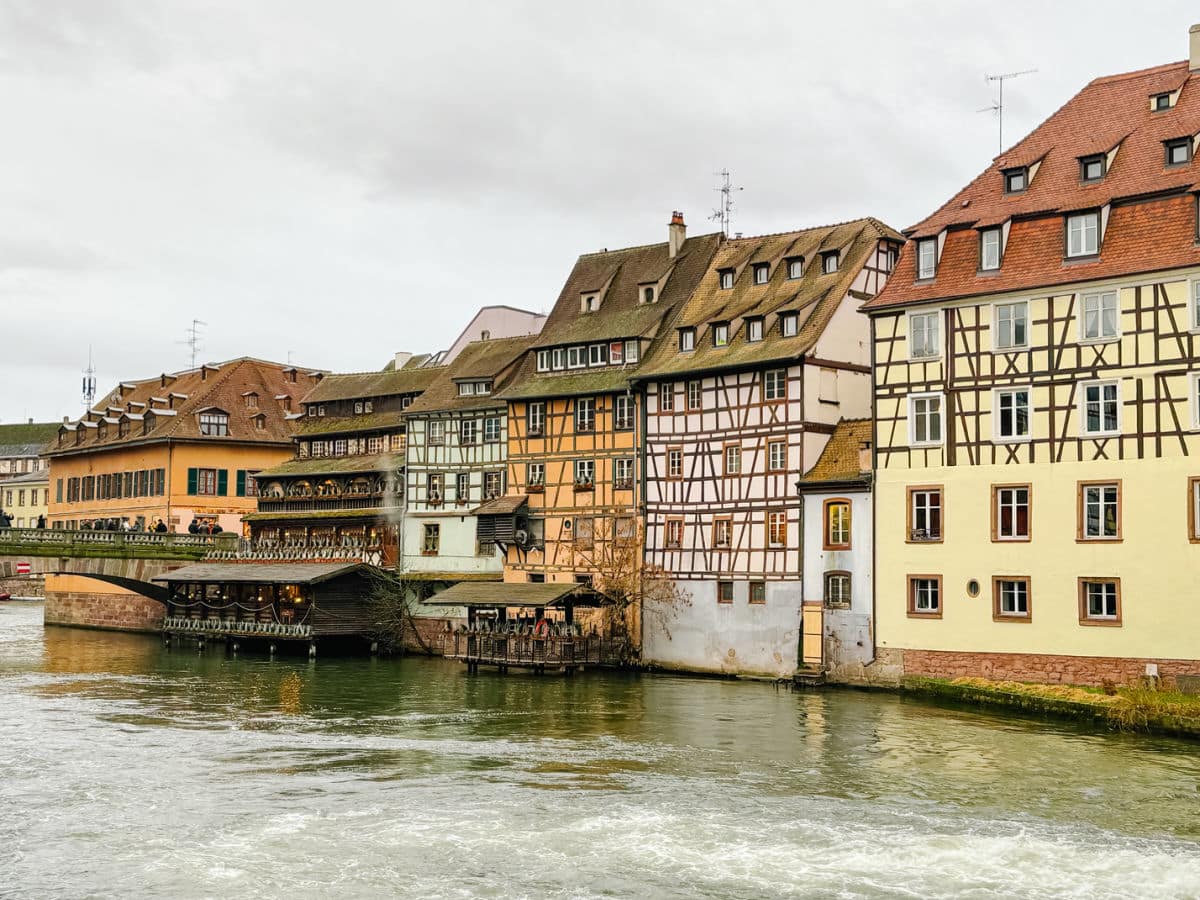
Strasbourg is a small city, rather than a town, but the Petite France neighborhood feels like a small village with shops and restaurants housed in some of Strasbourg’s gorgeous, old, half-timbered Alsatian houses. This captivating city seamlessly blends French and German influences.
The city’s most iconic landmark is the awe-inspiring Cathédrale Notre Dame de Strasbourg, a masterpiece of Gothic architecture that towers over the city center. Strasbourg is home to a UNESCO World Heritage Site, the Grande Île, which encompasses the historic center of the city. Within this charming area, you can wander along cobblestone streets lined with half-timbered houses, and soak in the lively atmosphere of squares like Place de la Cathédrale and Place Kléber.
For a glimpse into the city’s past, visit the Historical Museum of Strasbourg, housed in a 14th-century mansion, or the Alsatian Museum, which showcases the region’s rich cultural heritage. Of course, one of the most popular times to visit is from late November through Christmas to experience the traditional Christmas Markets. Personally, I found the lavish Christmas decorations that adorn so many businesses much more impressive than the Christmas Market itself, which was a little uninspired with repetitive food options and more commercial or imported gifts.
Colmar
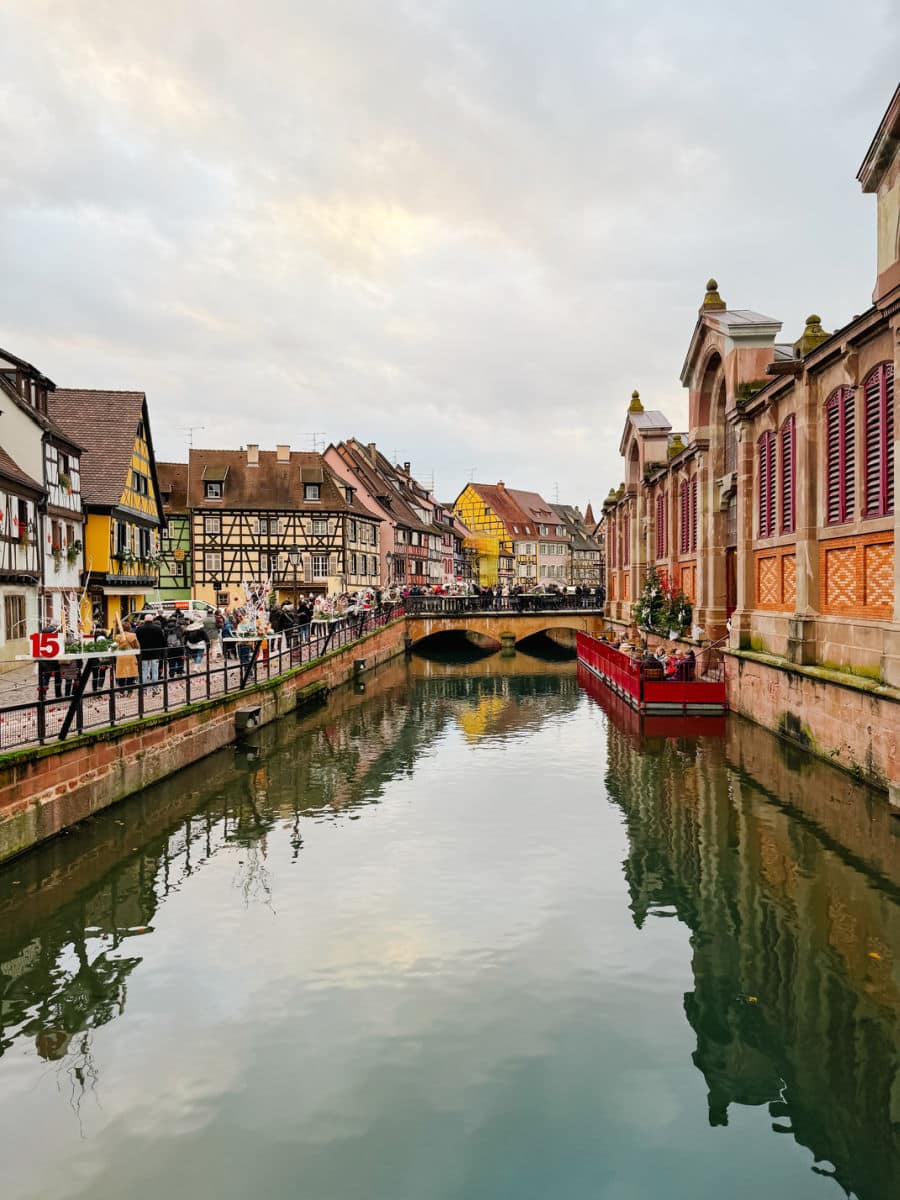
I thought Strasbourg was charming and then I went to Colmar and I had a hard time believing such places exist outside of Disney theme parks. Wandering its cobbled streets is like stepping into a storybook, where every corner overflows with charm.
Half-timbered houses painted in candy-colors lean against each other, with the stucco between the timbers giving them a “puffy” look that makes them appear like gingerbread houses that are fresh from the oven.
Little Venice, as the canal quarter is aptly nicknamed, is a must-see. You can take a boat tour to glide beneath arched bridges and past weeping willows, or simply stroll along the cobbled banks, stopping to admire the reflections of the colorful houses in the water.
For a taste of history, head to Unterlinden Museum, housed in a former Dominican convent. Here, you’ll find masterpieces by Renaissance masters like Grünewald and Schongauer, alongside the iconic “Virgin of the Rose Bush” by Martin Schongauer.
And no visit to Colmar is complete without indulging in its delectable Alsatian cuisine. Sample hearty flammekueche (a thin-crust pizza topped with onions and bacon) or try one of the town’s Michelin star restaurants.
Colmar is a must-visit during the holiday season for its popular Christmas Markets, which stretch throughout the city. A highlight is the Gourmet Market, where you can sample everything from foie gras to gourmet dishes such as Bouchée a la Reine, which is chicken, veal, and mushrooms in pastry (sort of a like a fancy pot pie.)
Obernai
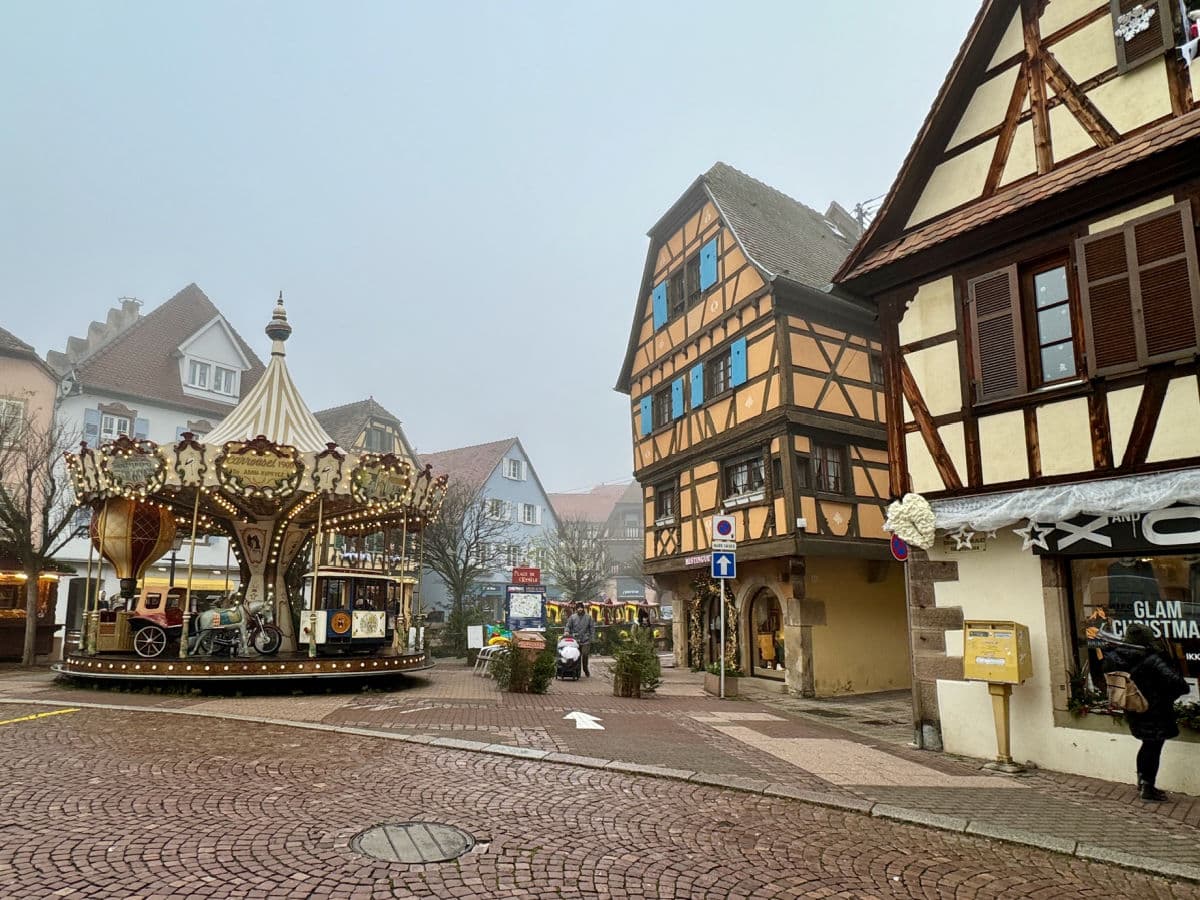
Obernai is located about midway between Strasbourg and Colmar and makes a lovely stop on the Alsace Wine Route. This darling small town has some of the best elements of the historic town center of Colmar, but without the crowds. The main street is lined with shops, similar to what you see in Colmar, from decor boutiques to cheesemongers. There are a handful of restaurants tucked in among the colorful half-timbered buildings, making it a perfect village to stop for lunch and some shopping.
If you do visit during the Christmas Market season, you will be happy to find a mostly local crowd, without the busloads of tourists you see in Riquewihr and Strasbourg. While the Christmas Market is small, they have some lovely gourmet offerings from foie gras to French cheeses and meats, to incredible homemade soup, chocolate, and pastries –giving it a reputation as a “foodie market”. You will even find pretzel-shaped doughnuts or beignets. We also thought the town’s version of mulled wine, cooked in a giant kettle, is one of the best, with a hint of vanilla.
Be sure to also take a look at the medieval ramparts, which still encircle the city. You will find a car park just outside of the ramparts or a parking garage in town. The car park leads you through the city gate into André Neher square and up Rue du Marché, where you will find the majority of the shops and restaurants.
Riquewihr
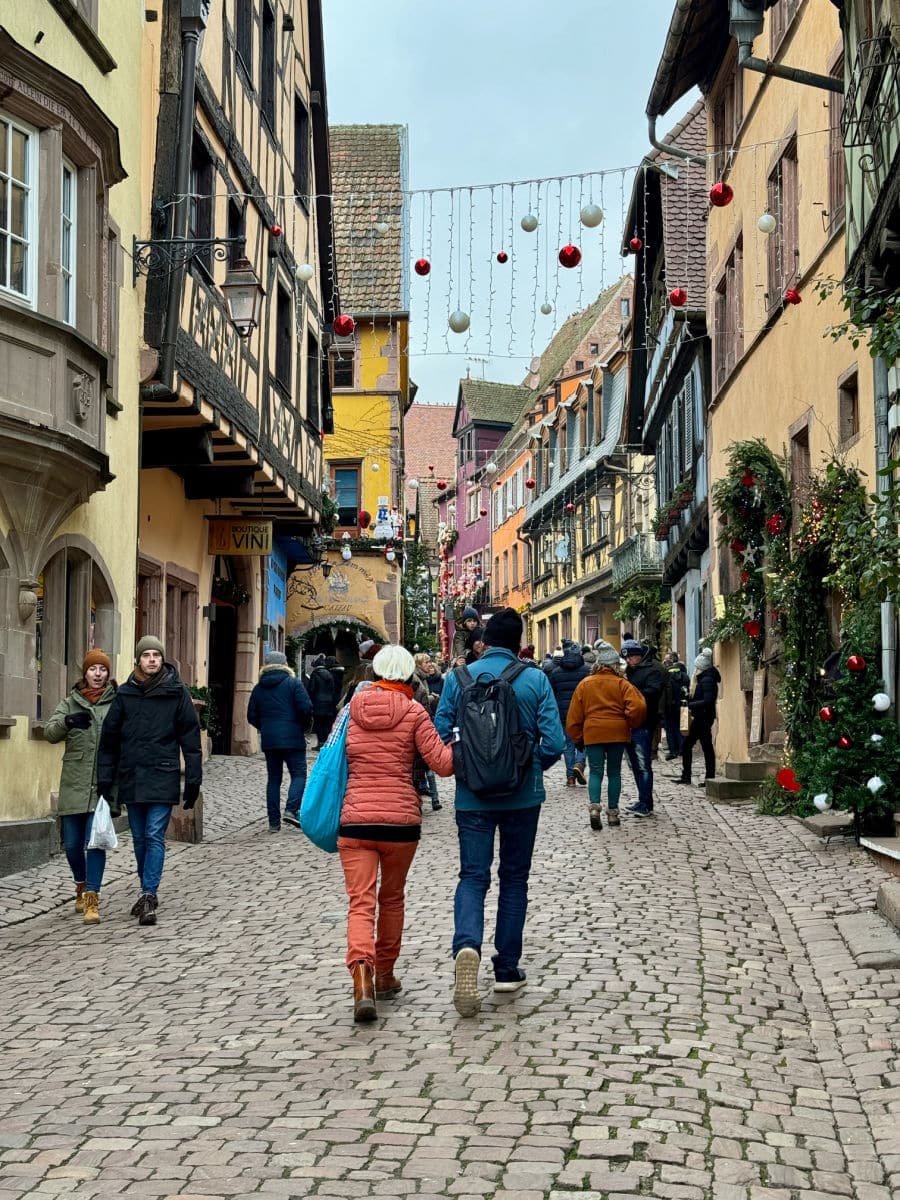
Riquewihr may be one of the prettiest villages in France, but I have to admit that it is not my favorite, at least not during the Christmas Market season. Located on the Alsace Wine Route, its cobbled streets are dotted with half-timbered winemakers’ shops and tasting rooms. I’d much prefer to visit in the summer or fall because during the Christmas season this tiny village is wall-to-wall people. We counted at least a dozen busses in the parking lot when we visited mid-week during December. On the weekends, it is worse when they run a shuttle from Strasbourg.
Maybe its popularity is due to being known as the inspiration behind Belle’s hometown in Disney’s beloved “Beauty and the Beast.” The setting is ultra-charming, with its curving, narrow streets of colorful buildings and glimpses down side streets that lead to the vineyard-covered hills just beyond. It just feels like it exists to be a tourist destination, instead of being a real town that tourists discovered, down to announcement being made over loudspeakers in four languages. There is such a thing as being too Disneyfied.
Tips for Visiting Small Towns in France
- Many small villages in France hold weekly markets with produce and goods from local farmers and artisans. Check ahead of visiting to see which days the market takes place.
- Parking is limited in these small towns but there is typically a car park with paid parking, so be sure to look for the pay station.
- While many people speak some English, even in small towns, it is helpful to know a little bit of French or have a good translation app.
- Most shops take credit cards or digital payments such as Apple Pay, but small cafes may be cash only. Also, make sure that you have either a Visa or Mastercard because many don’t accept American Express.
- Some towns have public toilets, but the cleanliness is not ensured. If you have to go, it is probably better to have a drink or cup of coffee at a local cafe and use their toilet instead. Often the public toilets are pay toilets, which is another reason to keep some coins on hand.
- When eating at restaurants or cafes, you can stay and people watch as long as you like, but keep in mind that you will need to ask for the check, refills, etc. There may also be a surcharge if you order bread or water.
Tamara is an over 50, award-winning travel writer, and recent empty nester based in Rhode Island. After years of writing about family travel on We3Travel and inspiring wanderlust as co-host of the Vacation Mavens family travel podcast, she started Your Time to Fly as a place to share ideas for girlfriend getaways, romantic escapes, and solo female travel for midlife women.

